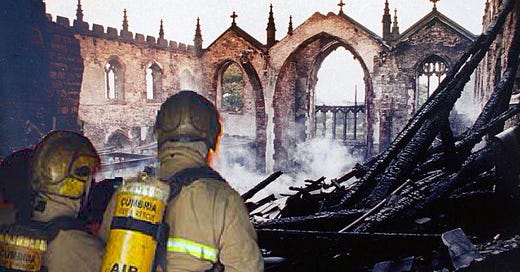How come Vikings invaded Cumbria…then disappeared?
An 800-year-old Workington church burned down. Cumbria's largest collection of Norse sculpture emerged underneath - but where did the incomers go?
Sometime on the night of 28th September 1994, an intruder broke into the ancient St Michael’s church on a hill above Workington. According to the local paper, they knocked over a candle that set fire to the priest’s robes.
The resulting blaze lit up the skies from Silloth to Whitehaven and gutted the holy building that dates back 800 years and sits on the site of a 1,300-year-old monastery.
Townspeople rallied together and raised £1.2 million to get the historic house of prayer rebuilt. But before reconstruction got under way church leaders handed a team of archaeologists a rare opportunity to look at what lay below the charred rubble.
What the team discovered was quite astonishing: the largest collection of Viking sculpture ever uncovered in Cumbria, including a mass of “hogback” grave covers and stonework covered with interlaced carving. This treasure trove suggested there had been a major incursion into Cumbria by wealthy Viking aristocrats with Norwegian and Irish roots more than a thousand years ago.
Finding Viking artefacts under a church is one thing. But where did these Scandinavians all live? As Nick Higham, Emeritus Professor of Medieval History at Manchester Unversity put it: “no proven example of a Scandinavian settlement has yet been located in north Cumbria.”
It is a major historical problem. The Vikings appear to have come into the area sometime after 900 AD on a large scale, created a mass of beautiful stone artefacts deeply imbued with Norse culture and iconography…and promptly vanished because there is very little other evidence of their presence.
This is strange because Vikings had earned a fearsome reputation in the eighth and ninth centuries for rape, pillage and plunder starting with their onslaught on the island of Lindisfarne off the coast of what is now Northumberland in 793 AD.
So why can’t we find any evidence in Cumbria of the same sort of surprise attacks and hacked bodies found elsewhere? Or did these particular Vikings decide that, this time, instead of wreaking havoc and high tailing it with Anglo Saxon loot, they would play nice and settle down in Cumbria?
If so, where are their towns, villages and houses? Cumbria and the Lake District has lots of places with names that contain Norse components, such as Keswick, Whitehaven, Ravenglass, Silloth, Ulverston and Ambleside. So why is there no evidence of buildings where Vikings lived?
Buy this book here: https://www.fletcherchristianbooks.com/details/p5921133_21146598.aspx
Keep reading with a 7-day free trial
Subscribe to Hidden Cumbrian Histories to keep reading this post and get 7 days of free access to the full post archives.




